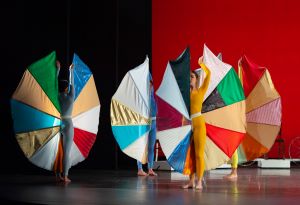It has been twenty years since John Rutter published his Requiem, jointly through Oxford University Press in London (for English and European users) and Hinshaw Music in Chapel Hill (for performances in the USA). At that time Rutter had been composing commissions for many years, pushing to meet deadlines, bound by the desires of others, and he had decided he wanted to write something for himself at his own pace. His father had died recently and he felt that it was the right time to compose his Requiem. (For some unknown reason composers write just one Requiem. They may write numerous masses, symphonies, string quartets, etc., but only one Requiem.)
He talked to his publishers, found a friend who agreed to perform it with his choir, and proceeded to work. “The Lord Is My Shepherd,” the sixth movement of the work, had been composed earlier but seemed to be waiting to fall into its special place. He had no desire to include the “Dies Irae,” as Berlioz and Verdi had done with such dramatic force. Rather, this would be a Requiem of comfort in the manner of Fauré and Duruflé, moving from sorrow and darkness in the first movement (“Requiem aeternam”) to hope and light in the last movement (“Lux aeterna”). He chose to use the framework of the Latin Mass but added some text from the Bible and the Book of Common Prayer. Rutter had no great expectations about future performances, though his friend Donald Hinshaw believed in it deeply. When the first recording hit the market, it took off like wildfire. and orders and requests for performance rights have continued to pour in. It is performed hundreds of times each year around the world and has been recorded by a number of outstanding choral groups. Apparently, Requiem has met a need that is basic in the human community: the need for comfort and hope in troubled times. There is little question that need will not diminish in any foreseeable future.
The August 3 performance by the outstanding Bel Canto Company of Greensboro in Duke Chapel was sponsored by Hinshaw Music and provided free to the public as a part of the Hinshaw Celebration XXXIII workshop. The program began with a welcome from Roberta Van Ness, President of Hinshaw Music, whose gentle and charming leadership has kept alive the enthusiasm for excellence in choral and organ music that was the hallmark of founder Donald Hinshaw. She deserves much credit for these fine choral workshops and outstanding concerts offered each year.
To open the concert, well-known and highly regarded church musician Robert Lau performed his spirited “Trumpet Tune” at the Flentrop organ. This was followed by a hymn setting by Howard Helvey of “Ride on, Ride on in Majesty” with congregational (audience) participation. Welborn Young next conducted the Bel Canto Company in an a cappella performance of “Nunc Dimittis” (sung in Latin) by the inspired Hungarian composer György Orbán. This ethereal music gave us a taste of the capabilities of Bel Canto for precision ensemble singing and rich, velvety sound.
Lau followed as guest conductor in four of his compositions: an arrangement of the lilting Scottish folk song “Gentle Annie.”, then his setting of “The Lord is My Shepherd”, “As I Went to Bethlehem,” and “Go Now in Peace,” each a work of skilled musicianship and worthy inspiration for any worship experience.
After intermission, Rutter took the podium to resounding applause. He began with his arrangement of “When I Survey the Wondrous Cross,” with Bel Canto and the large audience singing happily under his clear, crisp direction. “The Gift of Music” featured baritone Matt DiCamillo along with guitarist David Olson and flutist Laura Stevens. It has a lovely Irish-sounding lilt to it. Added to the published program was one of Rutter’s more recent compositions, written at the invitation of the Queen of England for performance at New Year’s service in the chapel of the Royal family’s private residence in Norfolk, Sandringham House. The piece, entitled simply “New Year,” makes the best of limited choral resources and was well liked by the Queen — and by the Duke Chapel audience.
Last on the program, Requiem was performed in an ensemble version for flute, oboe, three pedal timpani, glockenspiel, harp, cello, and organ. Adam Ward, the accompanist for Bel Canto, was guest organist for the concert. The ensemble arrangement gave a somewhat more intimate feel compared to the full orchestral version though there were a couple of places where the instruments overpowered the voices, from my perspective. The performance of the Requiem was a clear reminder of why this music is so widely heard and admired. It is mostly gentle, tuneful and inspiring. Rutter’s music fits and enhances the texts perfectly. The young musicians playing the ensemble parts did a very nice job. Bel Canto was responsive to the composer/conductor and as always displayed the highest level of musicianship. Special mention must be made of the solo work in the “Pie Jesu” and “Lux aeterna” by soprano Hannah Carter. Her voice was honey-smooth and rich and hauntingly beautiful in the soft higher pitches that were pure and clean as a trickling mountain stream.
Each time I hear Rutter’s Requiem, my admiration increases for his craftsmanship and the eloquence of his more fully developed music. I am grateful for his long-term relationship with Hinshaw Music, and for the opportunities afforded me to experience the charm of his music.











